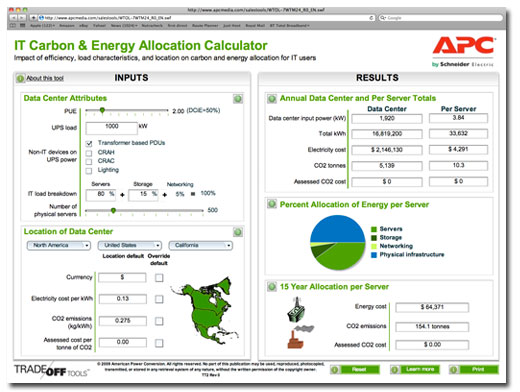APC by Schneider Electric's new online IT Carbon and Energy Allocation Calculator Trade-Off ToolTM demonstrates the impact that data centre efficiency, load characteristics and location have upon the carbon and energy cost allocation between servers, storage, networking and physical infrastructure equipment.

To get the most from the Tool, the user needs to input data centre attributes such as PUE (Power Usage Effectiveness), UPS load, which non-IT devices are on UPS power as well as providing an approximate percentage breakdown of servers, storage and networking equipment. The user also needs the number of physical servers being hosted in the facility.
The Tool has set defaults for electricity cost per kilowatt and CO2 emissions (kg/ kWh), although the user can opt to override these values as well as change the currency according to the location of the data centre. Using these inputs the IT Carbon and Energy Cost Calculator provides a series of outputs including the annual quantity and cost of energy used by the data centre as well as the carbon produced as a result, together with the same figures on a per server basis.
Altering the data centre PUE via a simple slider, the user can see the effect that increased efficiency has upon the total cost of running the facility as well as the 15 year cost (i.e., the facility lifetime cost) of running each server. A visual dashboard also indicates the division of energy between infrastructure and IT equipment as PUE is changed the simple rule being, the larger the green slice of the pie, the better PUE and the lower impact of running the data centre in terms of energy cost and carbon emissions.
For IT and data centre managers looking for a more developed methodology for allocating cost without deploying expensive and complex instrumentation, APC's White Paper 161; "Allocating Data Center Energy Costs and Carbon to IT Users" is a valuable asset. The paper advocates simple, no-cost models which can be easily built and applied effectively and logically for energy management. Such modeling is sufficiently accurate to inform decision making. It can also be enhanced over time by increasing the accuracy of inputs to improve the model, and therefore improve the process of reducing data centre energy use and carbon footprint.

Add a Comment
No messages on this article yet